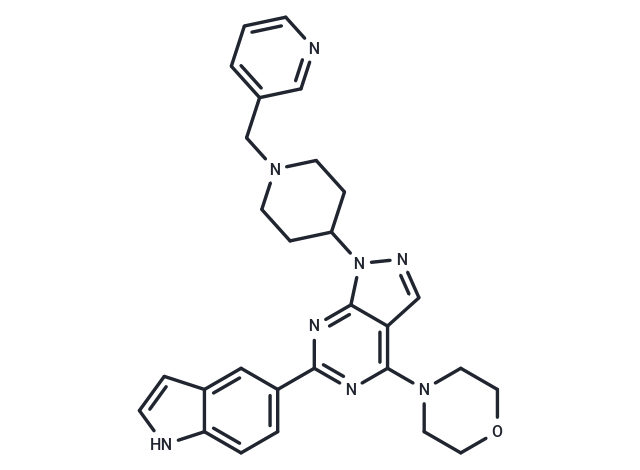Shopping Cart
Remove All Your shopping cart is currently empty
Your shopping cart is currently empty
WAY-600 is a potent, ATP-competitive, and selective inhibitor of mTOR with an IC50 of 9 nM; it blocks mTORC1/P-S6K(T389) and mTORC2/P-AKT(S473) but not P-AKT(T308), and is selective for mTOR over PI3Kα (>100-fold) and PI3Kγ (>500-fold).

| Pack Size | Price | USA Warehouse | Global Warehouse | Quantity |
|---|---|---|---|---|
| 1 mg | $32 | In Stock | In Stock | |
| 2 mg | $58 | In Stock | In Stock | |
| 5 mg | $98 | In Stock | In Stock | |
| 10 mg | $143 | In Stock | In Stock | |
| 25 mg | $258 | In Stock | In Stock | |
| 50 mg | $382 | In Stock | In Stock | |
| 100 mg | $533 | In Stock | In Stock | |
| 500 mg | Preferential | - | In Stock | |
| 1 mL x 10 mM (in DMSO) | $113 | In Stock | In Stock |
| Description | WAY-600 is a potent, ATP-competitive, and selective inhibitor of mTOR with an IC50 of 9 nM; it blocks mTORC1/P-S6K(T389) and mTORC2/P-AKT(S473) but not P-AKT(T308), and is selective for mTOR over PI3Kα (>100-fold) and PI3Kγ (>500-fold). |
| Targets&IC50 | PI3Kγ:8.45 μM, mTOR:9 nM, PI3Kα:1.96 μM |
| In vitro | Immune-complex kinase assay shows mTORC2-specific substrate His6-AKT or the mTORC1 substrate His6-S6K is dose dependently inhibited by WAY-600. WAY-600 globally inhibits mTOR signaling and AKT function in cellular models dose dependently. WAY-600 profoundly inhibits cap-dependent and global protein synthesis in MDA361, human breast cancer cells. WAY-600 shows antiproliferative effects in various cancer cell lines involving G1 cell cycle arrest and selective apoptosis. WAY-600 down-regulate angiogenic factors, VEGF and HIF-1α, in U87 mg, MDA361 and LNCap cells. [1] |
| Kinase Assay | DELFIA Format of Purified FLAG-TOR: The routine assays with purified FLAG-TOR (FL and 3.5) are performed in 96-well plates as follows. Enzymes are first diluted in kinase assay buffer (10 mM Hepes (pH 7.4), 50 mM NaCl, 50 mM β-glycerophosphate, 10 mM MnCl2, 0.5 mM DTT, 0.25 lM microcystin LR, and 100 lg/mL BSA). To each well, 12 μL of the diluted enzyme is mixed briefly with 0.5 μL test inhibitor or control vehicle dimethyl sulfoxide (DMSO). The kinase reaction is initiated by adding 12.5 μL kinase assay buffer containing ATP and His6-S6K to give a final reaction volume of 25 μL containing 800 ng/mL FLAG-TOR, 100 μM ATP, and 1.25 μM His6-S6K. The reaction plate is incubated for 2 hours (linear at 1–6 hour) at room temperature with gentle shaking and then terminated by adding 25 μL Stop buffer (20 mM Hepes (pH 7.4), 20 mM EDTA, and 20 mM EGTA). The DELFIA detection of the phosphorylated (Thr-389) His6-S6K is performed at room temperature using a monoclonal anti-P(T389)- p70S6K antibody (1A5) labeled with Europium-N1- ITC (Eu) (10.4 Eu per antibody). Fortyfive microliters of the terminated kinase reaction mixture are transferred to a MaxiSorp plate containing 55 μL PBS. The His6-S6K is allowed to attach for 2 hour after which the wells are aspirated and washed once with PBS. One hundred microliters of DELFIA buffer with 40 ng/mL Eu-P(T389)-S6K antibody is added. The antibody binding is continued for 1 hour with gentle agitation. The wells are then aspirated and washed four times with PBS containing 0.05% Tween 20 (PBST). One hundred microliters of DELFIA Enhancement solution is added to each well and the plates are read in a PerkinElmer Victor model plate reader. Data obtained are used to calculate enzymatic activity and enzyme inhibition by potential inhibitors. |
| Cell Research | For cell cycle analysis, cells are seeded in 96-well culture plates at 10,000 cells per well for 24 hours, treated with various inhibitors for 24 hours or 48 hours. Following treatment, cells are harvested, washed with PBS and fixed overnight at -20 °C in 70% ethanol. Cells are washed, stained with propidium iodide and analyzed for cell cycle profile (acquired 5000 cells/well) on Guava PCA-96 instrument according to the Guava Cell Cycle Protocol(Only for Reference) |
| Synonyms | WAY600 |
| Molecular Weight | 494.59 |
| Formula | C28H30N8O |
| Cas No. | 1062159-35-6 |
| Smiles | C(N1CCC(CC1)n1ncc2c(nc(nc12)-c1ccc2[nH]ccc2c1)N1CCOCC1)c1cccnc1 |
| Relative Density. | 1.43 g/cm3 |
| Storage | Powder: -20°C for 3 years | In solvent: -80°C for 1 year | Shipping with blue ice/Shipping at ambient temperature. | |||||||||||||||||||||||||||||||||||
| Solubility Information | Ethanol: 2 mg/mL (4.04 mM), Sonication is recommended. H2O: < 1 mg/mL (insoluble or slightly soluble) DMSO: 45 mg/mL (90.98 mM), Sonication is recommended. | |||||||||||||||||||||||||||||||||||
| In Vivo Formulation | 10% DMSO+40% PEG300+5% Tween 80+45% Saline: 2 mg/mL (4.04 mM), Sonication is recommended. Please add the solvents sequentially, clarifying the solution as much as possible before adding the next one. Dissolve by heating and/or sonication if necessary. Working solution is recommended to be prepared and used immediately. The formulation provided above is for reference purposes only. In vivo formulations may vary and should be modified based on specific experimental conditions. | |||||||||||||||||||||||||||||||||||
Solution Preparation Table | ||||||||||||||||||||||||||||||||||||
Ethanol/DMSO
DMSO
| ||||||||||||||||||||||||||||||||||||
| Size | Quantity | Unit Price | Amount | Operation |
|---|

Copyright © 2015-2025 TargetMol Chemicals Inc. All Rights Reserved.